Experimental Study of the Effect of Axial Load on Stress Wave Characteristics of Rock Bolts Using a Non-Destructive Testing Method
Abstract
:1. Introduction
2. Experimental Work
2.1. The Test Equipment
2.2. The TEST Scheme
3. Analysis of Test Results
3.1. Stress–Strain Analysis under Axial Load
3.2. Filtering of Reflected Stress Wave Signal of Rock Bolt Excitation
3.3. Time and Frequency Analysis of the Filtered Signal Based on Hilbert-Yellow
3.4. Rock Bolt “Axial Load-Stress Wave Time-Domain Amplitude” Law Analysis
4. Experimental Verification of Rock Bolt Axial Load Test Based on Time-Domain Amplitude of Reflected Stress Wave of Excitation
5. Conclusions
- (1)
- The collected excitation–emission stress wave signal can be successfully filtered by using VMD decomposition and FFT low-pass filter. The analysis of the time domain characteristic parameters showed that the decay rate of the first cycle of the stress waveform in the time domain changed with the increase in the axial load; the processing of the frequency domain data using the FFT low-pass filter showed that the peak amplitude and shape of the stress waveform in the frequency domain were also affected by the axial load.
- (2)
- For an intact and well-compacted rock bolt, the changes in axial load on the stress waveform signal characteristics of the rock bolt cannot be directly reflected from the time domain waveform and Fourier frequency domain and should be analyzed by combining multiple signal processing methods. The analysis results show that with the increase in axial load, the stress wave characteristics of the rock bolt change, and the time domain amplitude of the stress wave gradually decreases.
- (3)
- The axial load of the rock bolt was determined by a dynamometer test and compared with the load value of the tensile machine to verify the nondestructive testing method based on the stress wave method used in this paper. The error of the method used in this paper is much smaller than that of the traditional anchor load test method, and the test results are more stable and were further applied to determine the working load of anchor rods.
Author Contributions
Funding
Institutional Review Board Statement
Informed Consent Statement
Data Availability Statement
Conflicts of Interest
References
- Kang, H. Seventy years of development of coal mine roadway rock control technology in China and its outlook. J. Rock Mech. Eng. 2021, 40, 1–30. [Google Scholar]
- Dong, J.; Zheng, G.; Yang, D. Study on FBG anchors for safety monitoring of anchor-supported retracement roadways. J. Min. Saf. Eng. 2022, 39, 328–334. [Google Scholar]
- Yao, Q.; Li, Y.; Xia, Z.; Li, X.; Wang, X.; Chao, N. Theory and application of superimposed beam support for coal system roadway roof based on effective anchorage layer thickness. J. Coal 2022, 47, 672–682. [Google Scholar]
- Liu, L.; Chen, Y.; Zhang, C.; Hua, Y.; Niu, Y.; Zhou, C. Research status of elastic wave detection technology for anchor quality. Coal Mine Saf. 2019, 50, 136–139. [Google Scholar]
- Zhang, H.; Wu, Y.; Chen, Y.; Zhang, G. Nondestructive testing method and application of coal mine anchor installation quality. J. Min. Saf. Eng. 2018, 35, 283–290. [Google Scholar]
- Hao, Y.; Wu, Y.; Zhang, K.; Li, P.; Meng, Q. Analysis of vibration characteristics of anchor system during shaft force testing of coal mine anchors. J. Min. Saf. Eng. 2022, 39, 567–575. [Google Scholar]
- Fan, K.; Shen, B.; Liu, S.; Jiao, J. Numerical experiments and applications of stress wave propagation characteristics of anchor solids in roadway roofs. J. Min. Saf. Eng. 2018, 35, 245–253. [Google Scholar]
- Zhang, W.; Wei, S.; Zou, N.; Zhu, D. Experimental study of pile foundation dynamic testing used in the rock bolt nondestructive testing. Appl. Mech. Mater. 2012, 166, 559–562. [Google Scholar] [CrossRef]
- Thurner, H.F. Boltometer-Instrument for non-destructive testing of grouted rock bolts. Proc. Second. Int. Symp. Filed Meas. Geomach. 1988, 40, 135–143. [Google Scholar]
- Beard, M.D.; Lowe, M.; Cawley, P. Ultrasonic guided waves for inspection of grouted tendons and bolts. J. Mater. Civ. Eng. 2003, 15, 212–218. [Google Scholar] [CrossRef]
- Beard, M.D.; Lowe, M.J. Non-destructive testing of rock bolts using guided ultrasonic waves. Int. J. Rock Mech. Min. Sci. 2003, 40, 527–536. [Google Scholar] [CrossRef]
- Ivanovic, A.; Neilson, R.D.; Rodger, A.A. Numerical modeling of single tendon ground anchorage systems. Proc. Inst. Civ. Eng. -Geotech. Eng. 2001, 149, 103–113. [Google Scholar] [CrossRef]
- Rodger, A.A.; Littlejohn, G.S.; Holland, D.C. Dynamic response of rock bolt systems at Peny Clip Tunnel in North Wales. Dev. Geotech. Eng. 1993, 74, 719–727. [Google Scholar]
- Holland, D.C.; Charles, D. The behaviour of resin bonded rock bolts and other anchorages, subjected to close proximity blasting. In Proceedings of the 8th International Congress on Rock Mechanics, Tokyo, Japan, 25–29 September 1995; pp. 665–670. [Google Scholar]
- Li, Y.; Wang, C. Experimental study of stress reflection wave method for testing anchor quality of rock bolts. J. Coal 2000, 25, 160–164. [Google Scholar]
- Liu, H.; Yang, W.; Li, Y. Nondestructive testing technology for early anchorage quality of full-length rock bolts. J. Coal 2007, 10, 1066–1069. [Google Scholar]
- Zhang, C.; Li, Y.; Zhao, Y.; Steve, Z. Study on excitation waves in nondestructive testing of rock bolt anchorage quality. J. Rock Mech. Eng. 2006, 25, 1240–1245. [Google Scholar]
- Wang, M.; Li, Y.; Dong, J. Field experimental study on nondestructive testing of anchor quality of rock bolts by stress wave method. Coal Technol. 2013, 32, 203–204. [Google Scholar]
- Li, Q.; Mao, X.; Xu, J.; Ouyang, C. Principle and application of elastic wave detection for prestressed anchors. J. Min. Saf. Eng. 2007, 24, 32–36. [Google Scholar]
- Li, Q.; Zhu, C.; Duan, Y. Numerical simulation of dynamic characteristics of a prestressed anchor support system. J. Coal 2008, 33, 727–731. [Google Scholar] [CrossRef]
- Wang, S.; Xu, J.; Wu, R. Study on the excitation wave and its propagation law for elastic wave detection of prestressed anchors. J. Min. Saf. Eng. 2011, 28, 581–584. [Google Scholar]
- Qin, C.; Niu, L.; Zhu, W.; Zhang, N. Experimental study of stress wave propagation in mortar full-length bonded anchors. Exp. Mech. 2021, 36, 725–734. [Google Scholar]
- Liang, T.; Feng, J.; Bian, D.; Yan, D.; Li, Y. Research on nondestructive testing of rock bolt working load based on box dimension. J. Taiyuan Univ. Technol. 2015, 46, 327–331. [Google Scholar]
- Xu, M.; Zhang, Y. Wavelet analysis method for quality inspection of anchorage system. Geotechnics 2003, 24, 262–265. [Google Scholar] [CrossRef]
- Zhang, J.; Li., K.; Zhang, H.; Wang, N.; Guo, Q.; Zhao, L. Research on nondestructive testing method of GFRP anchor quality based on HHT signal analysis. J. Rock Mech. Eng. 2021, 40, 1460–1472. [Google Scholar]
- Tang, Y. High-Performance Low-Pass Filter; University of Electronic Science and Technology: Chengdu, China, 2009. [Google Scholar]
- Zhang, L.; Huang, Z.; Bai, L.; Ma, Z.; Mao, X.; Chen, Z. Multiscale entropy analysis of nondestructive detection signals of anchor rod anchorage defects. J. China Univ. Min. Technol. 2021, 50, 1077–1086. [Google Scholar]
- Yang, G.; Liu, Y.; Wang, Y.; Zhu, Z. EMD interval thresholding denoising based on similarity measure to select relevant modes. Signal Process. 2015, 109, 95–109. [Google Scholar] [CrossRef]
- Li, W.; Jiang, H.; Zhao, Z.; Pan, R.; Hu, K. Application of empirical modal decomposition algorithm based on waveform matching endpoint extension method optimization to railroad relay parameter noise reduction. J. Electr. Eng. Technol. 2022, 37, 2656–2664. [Google Scholar]
- An, X.; Yang, J. Denoising of hydropower unit vibration signal based on variational mode decomposition and approximate entropy. Trans. Inst. Meas. Control. 2016, 38, 282–292. [Google Scholar] [CrossRef]
- Zhan, Y.; Cheng, L.; Wang, T. Fault diagnosis performance optimization method for decoupled multi-frequency empirical modal decomposition. Vib. Shock. 2020, 39, 115–122, 149. [Google Scholar]
- Rehman, N.U.; Aftab, H. Multivariate Variational Mode Decomposition. IEEE Trans. Signal Process. 2019, 67, 6039–6052. [Google Scholar] [CrossRef] [Green Version]
- Liu, W.; Cao, S.; Wang, Z. Application of variational mode decomposition to seismic random noise reduction. J. Geophys. Eng. 2017, 14, 888–899. [Google Scholar]
- Xu, F.; Chang, J.; Liu, B. Research on VMD-based denoising method for lidar echo signal. Laser Infrared 2018, 48, 1443–1448. [Google Scholar]
- Wang, Y.; Markert, R.; Xiang, J.; Zheng, W. Research on variational mode decomposition and its application in detecting a rub-impact fault of the rotor system. Mech. Syst. Signal Process. 2015, 60–61, 243–251. [Google Scholar] [CrossRef]
- Xu, J.; Ren, Q.; Huang, L. Analysis of ground-penetrating radar signals based on variational modal decomposition. J. Hen Hai Univ. Nat. Sci. Ed. 2018, 46, 545–550. [Google Scholar]
- Wang, J. Research on Signal Denoising Method Based on Variational Modal Decomposition; Liaoning Normal University: Dalian, China, 2018. [Google Scholar]
- Zhong, Z.; Ma, L.; Cai, Z.; Duan, Y.; Chen, J. Rotor unbalance fault diagnosis method based on VMD_MPE and FCM clustering under variable speed conditions. Vib. Shock. 2022, 41, 290–298. [Google Scholar]
- Sun, K.; Yue, M.; Jin, J.; Li, C. Fault diagnosis of rolling bearings based on improved variational modal decomposition and streamlined learning. Therm. Power Eng. 2022, 37, 176–185. [Google Scholar]
- Shi, P.; Zhang, H.; Han, D. Research on bearing fault diagnosis method based on improved adaptive multivariate modal decomposition. J. Power Eng. 2022, 42, 129–137. [Google Scholar]
- Xiao, B.; Liu, J.; Xu, X.; Qin, H.; Xie, W. Adaptive synchronous compressed short-time Fourier transform based on wavelet packet decomposition. China Science and Technology Paper, 13 June 2022; 1–7. [Google Scholar]
- Zhu, Y.; Hu, J.; Li, W.; Lin, Q.; Yi, C. Short-time Fourier transform based on frequency domain window function and its application in mechanical shock feature extraction. Mach. Tools Hydraul. 2021, 49, 177–182. [Google Scholar]
- Liu, F.; Han, Z.; Zeng, R. A method for reconstructing radar signals under weak observation conditions based on variational modal decomposition and compressive sensing. J. Electron. Inf. 2021, 43, 1644–1652. [Google Scholar]
- Zhao, X.; Yang, Z.; Zhang, B.; Li, M.; Wang, G.; Wang, X. Research on high preload lengthened anchorage support technology for deep fractured surrounding rock. Coal Technol. 2022, 41, 8–12. [Google Scholar]
- Wang, W.; Han, S.; Dong, E.; Peng, G. Simulation experimental study of rock block anchorage mechanism. J. Coal 2021, 1987, 1–9. [Google Scholar]
- Wang, F.; Zhou, X.; Yan, B. Fault diagnosis of rolling bearings based on eigenvalue fusion and support vector machine. Sci. Technol. Eng. 2022, 22, 2351–2356. [Google Scholar]
- Wang, K.; Yan, M.; Sun, Z.; Su, D.; Hui, A.; Liu, H. Factors affecting nonlinear stiffness of bolted flange connection structures under different loads. J. Aerodyn. 2021, 36, 2503–2514. [Google Scholar]
- Yang, J.; Lv, J. FFT filtering error analysis. Commun. Technol. 2010, 43, 235–237, 240. [Google Scholar]
- Huang, N.; Shen, Z.; Long, S. The empirical mode decomposition and the Hilbert spectrum for nonlinear and nonstationary time series analysis. Proc. Math. Phys. Eng. Sci. 1998, 454, 903–995. [Google Scholar] [CrossRef]
- Huang, N.; Wu, M.; Long, S. A confidence limit for the empirical mode decomposition and Hilbert spectral analysis. Proc. Math. Phys. Eng. Sci. 2003, 459, 2317–2345. [Google Scholar] [CrossRef]
- Wei, J.; Gu, X.; Ning, F. Hilbert-time spectral feature extraction method. J. Huazhong Univ. Sci. Technol. Nat. Sci. Ed. 2021, 49, 50–54. [Google Scholar]
- Yang, Y.; Chen, W.; Wang, Y.; Tang, D.; Zhao, J.; Guo, H.; Guo, Y. Failure analysis of liquid rocket engine turbopump based on Hilbert-Huang transform. J. Tsinghua Univ. Nat. Sci. Ed. 2022, 62, 540–548. [Google Scholar]
- Guo, Y.; Shao, H.; Gong, D.; Li, H.; Chen, L. Atrial fibrillation detection based on Hilbert yellow transform and deep convolutional neural network. J. Electron. Inf. 2022, 44, 99–106. [Google Scholar]
- Wang, L. Fundamentals of Stress Waves; Beijing Defense Industry Press: Beijing, China, 1985. [Google Scholar]
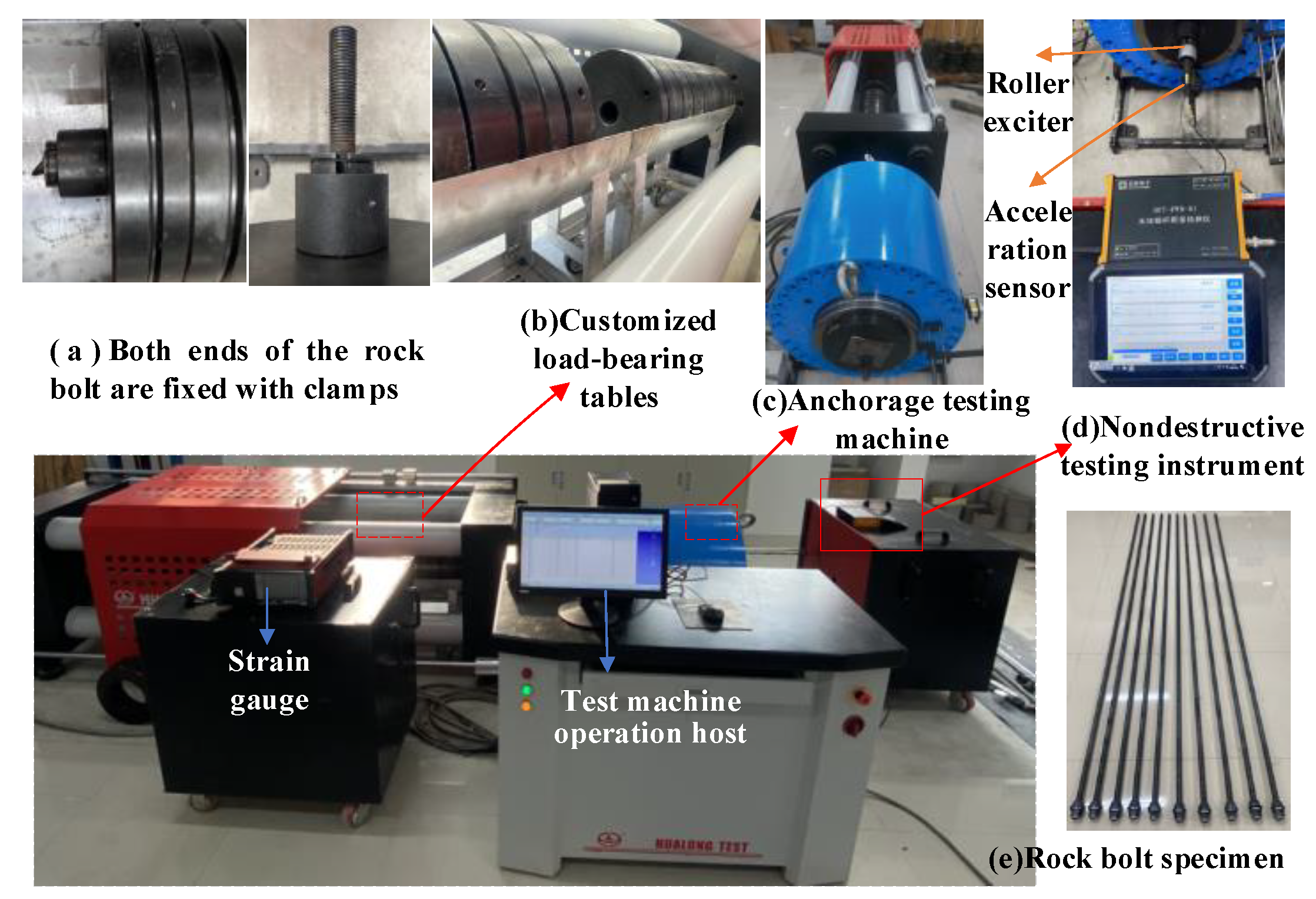

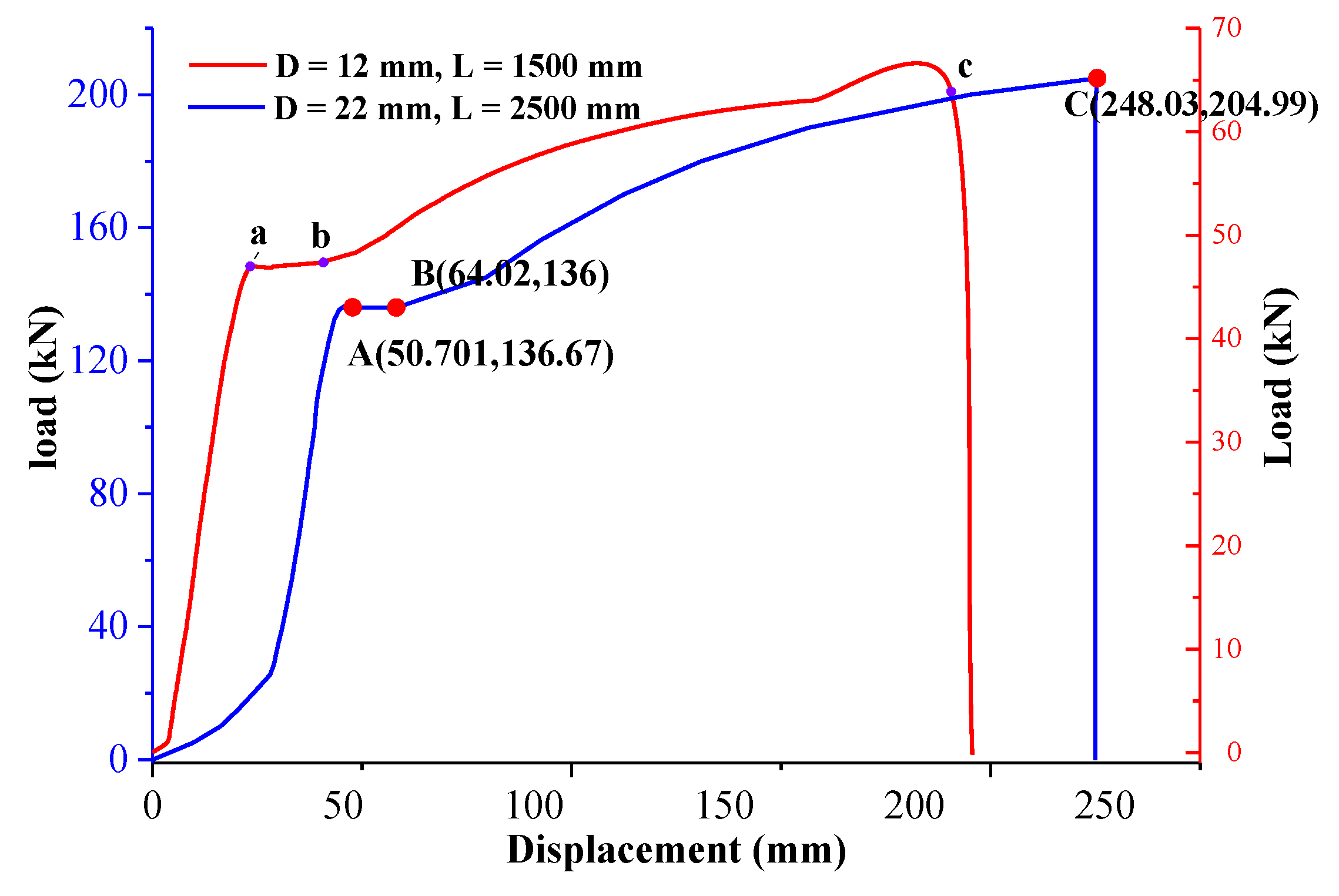

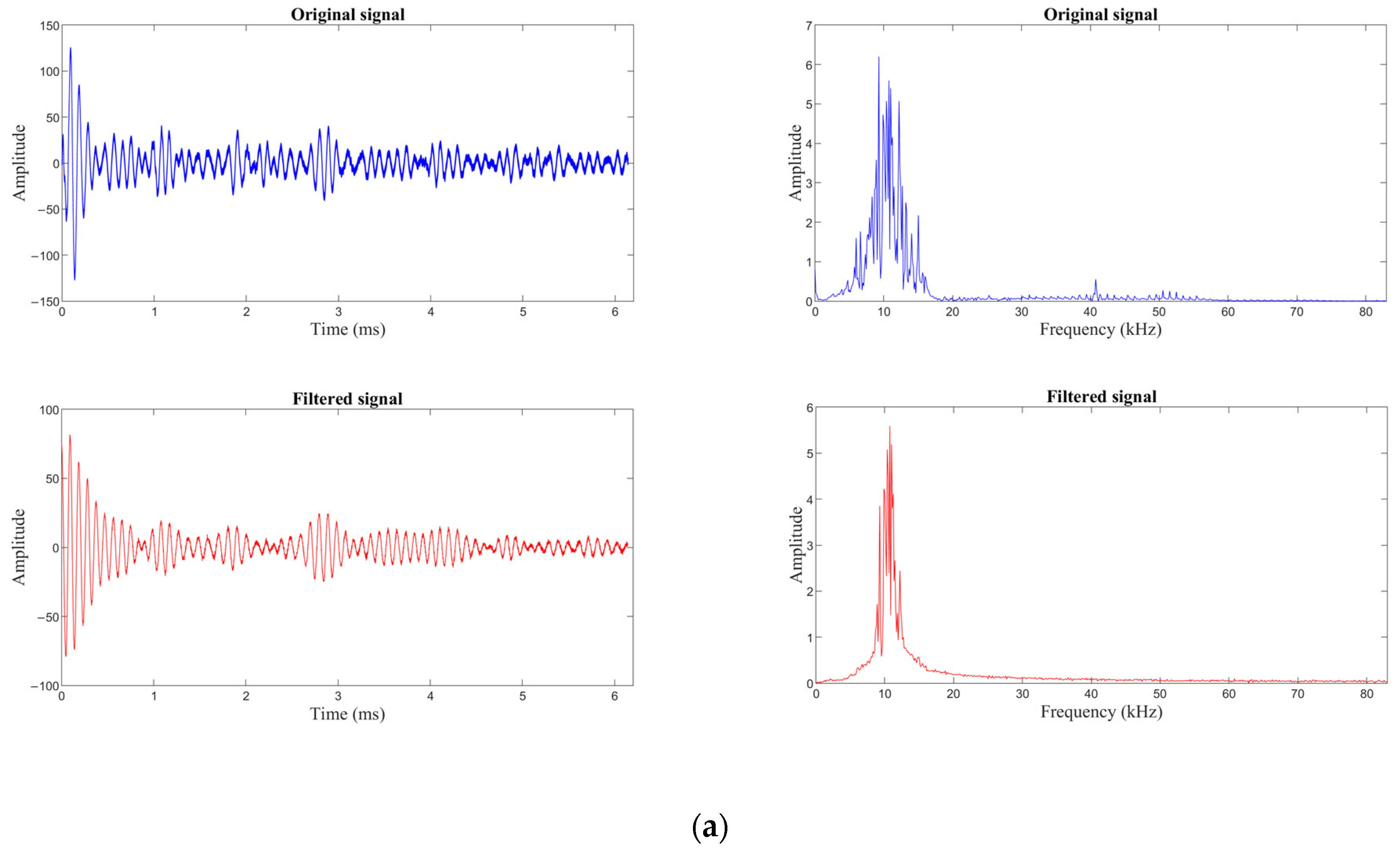



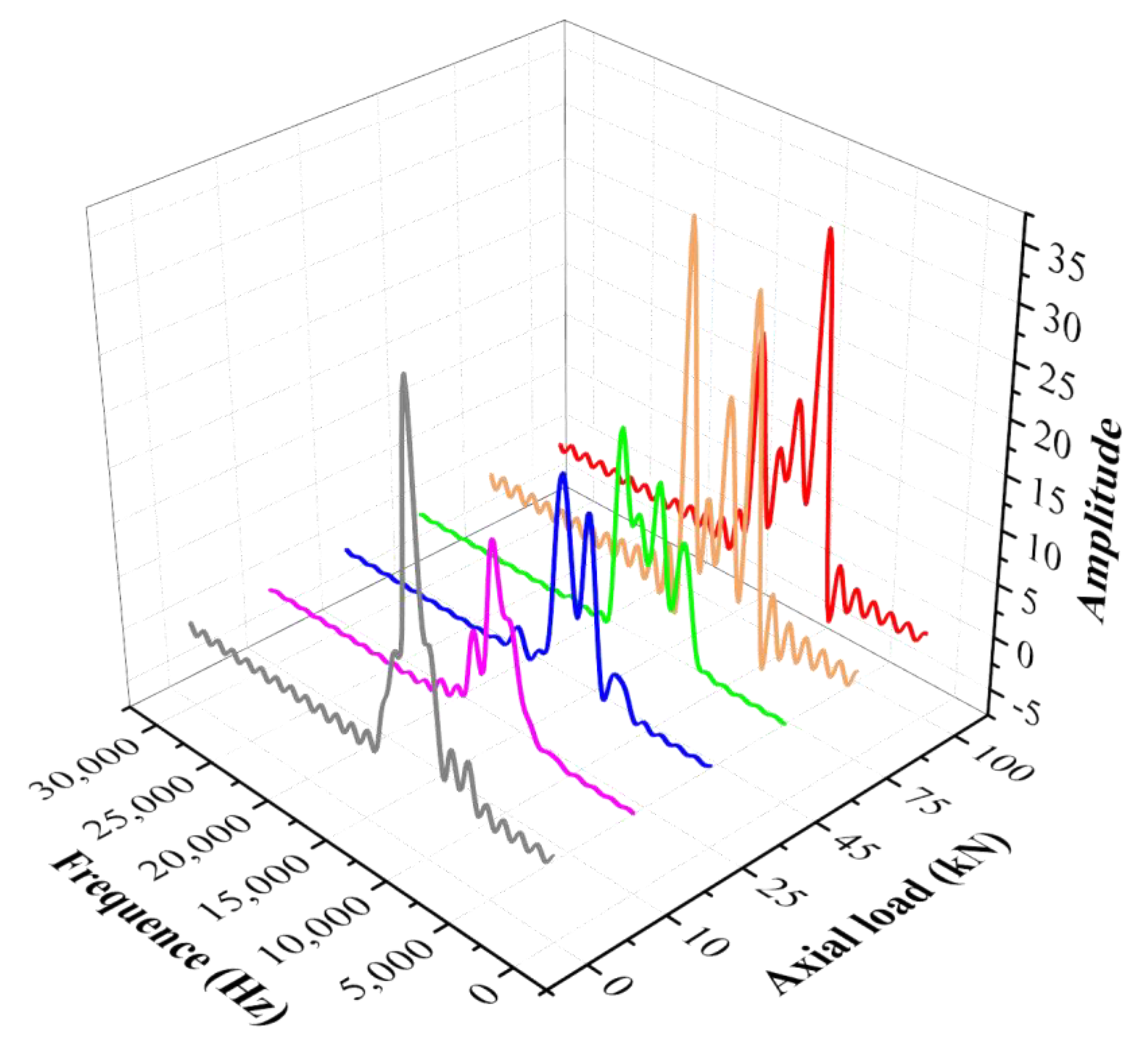
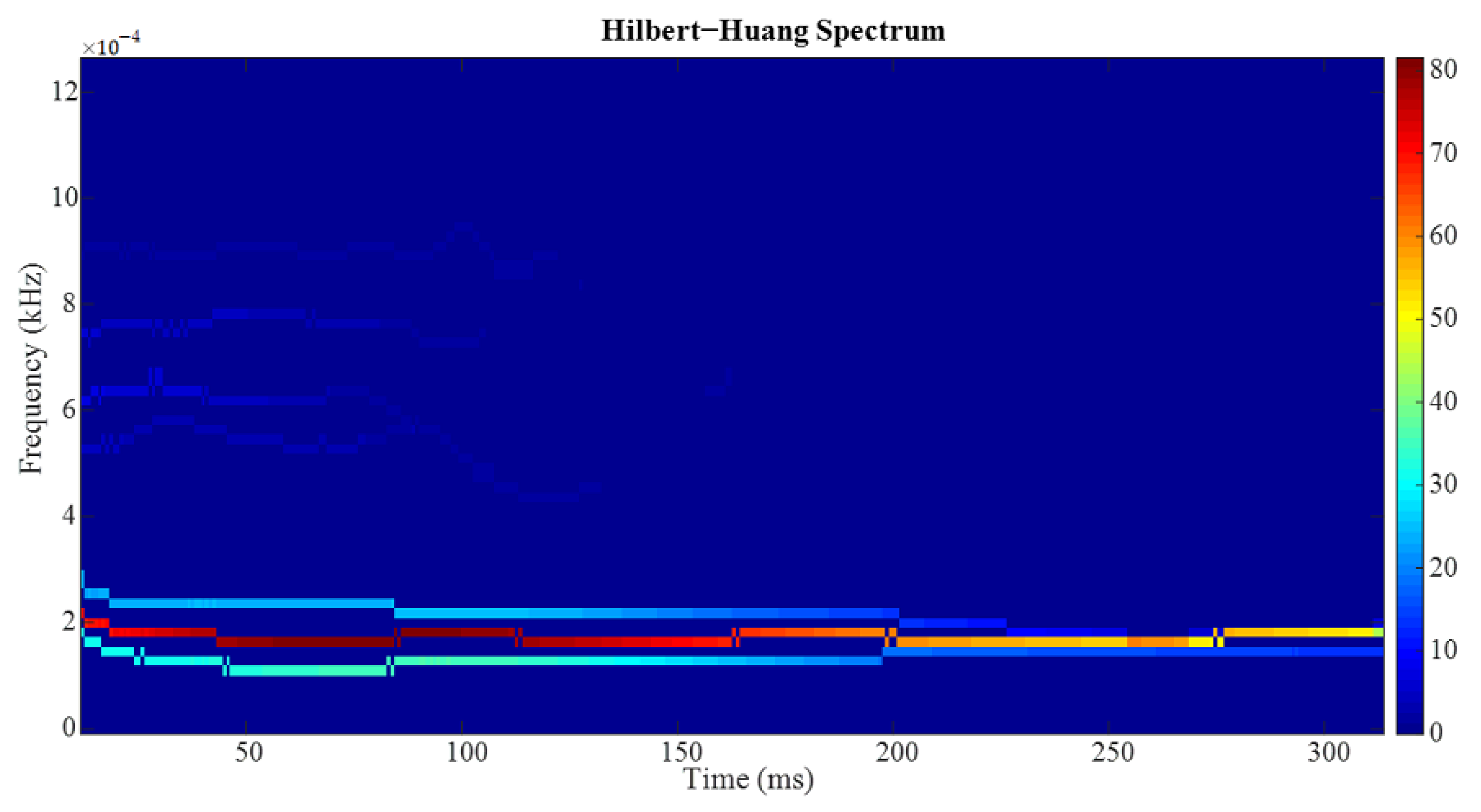

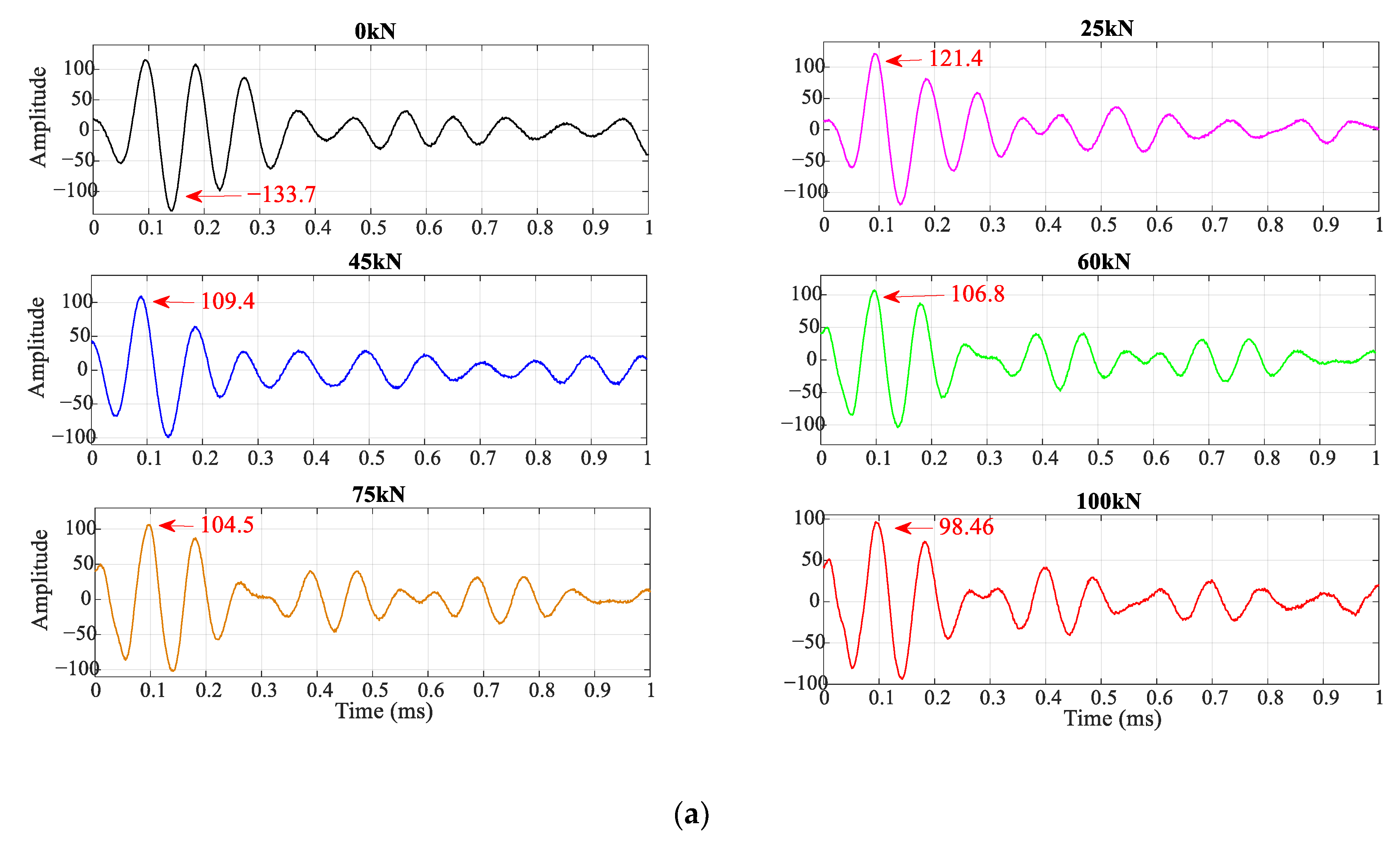

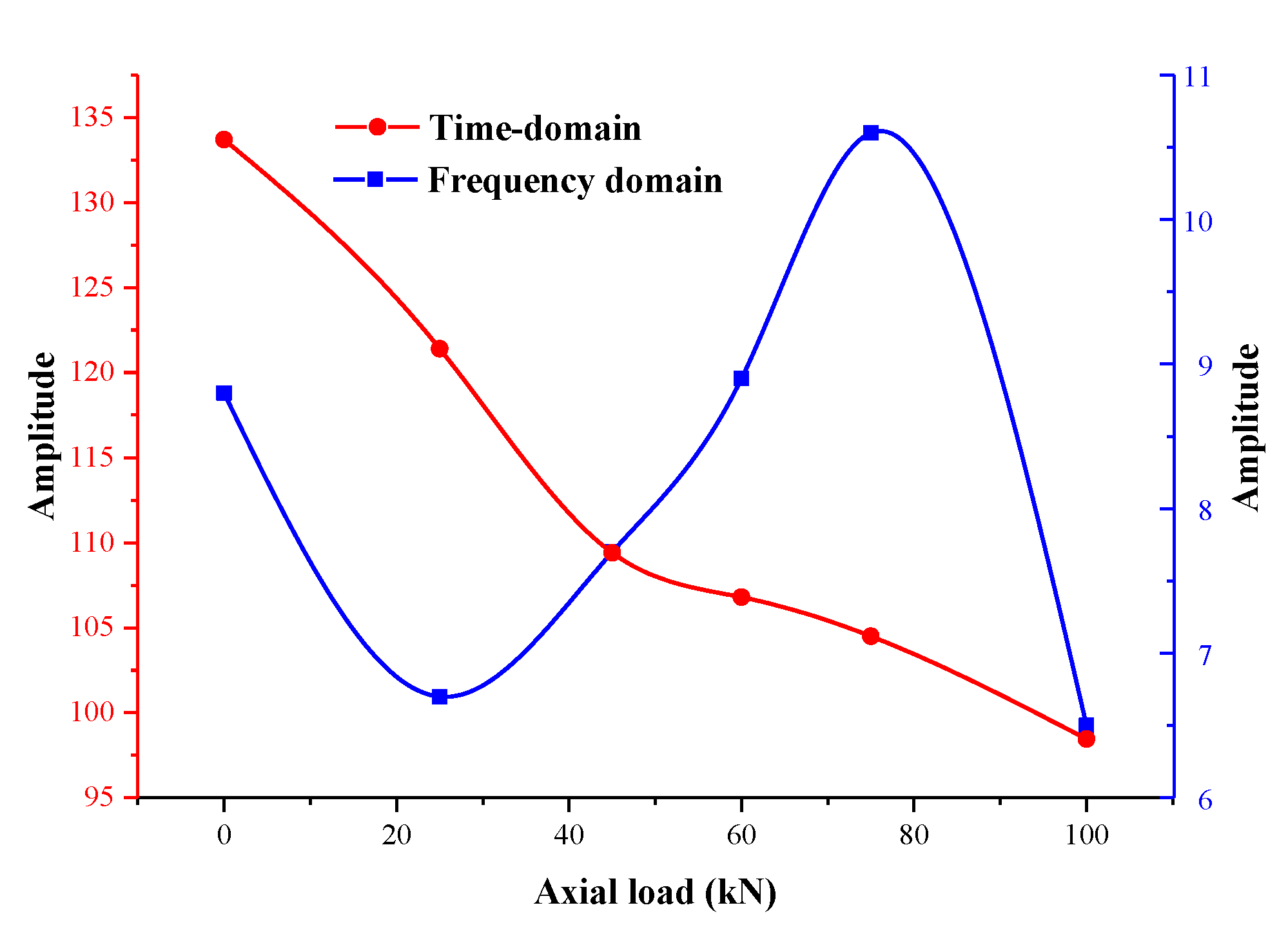
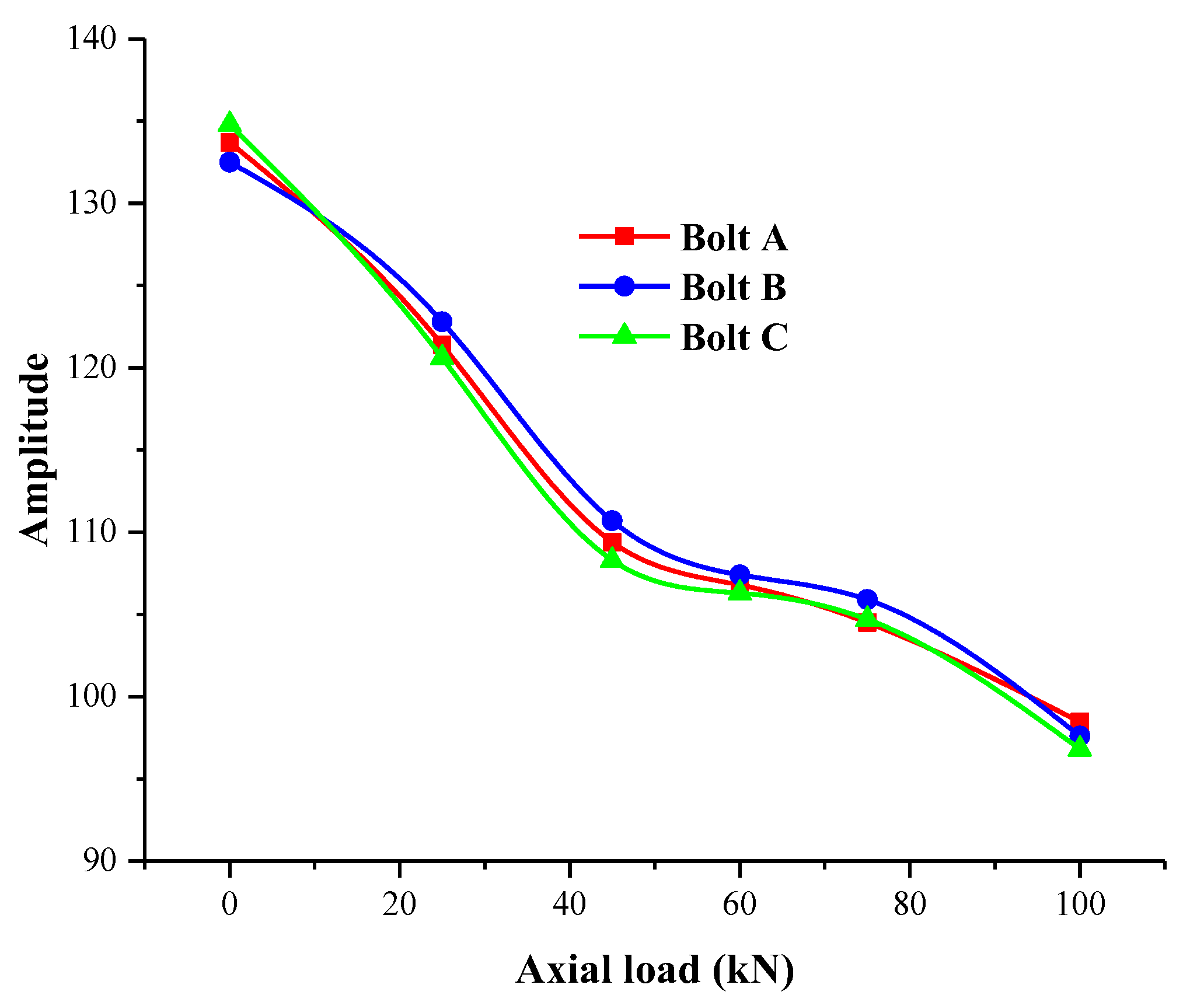

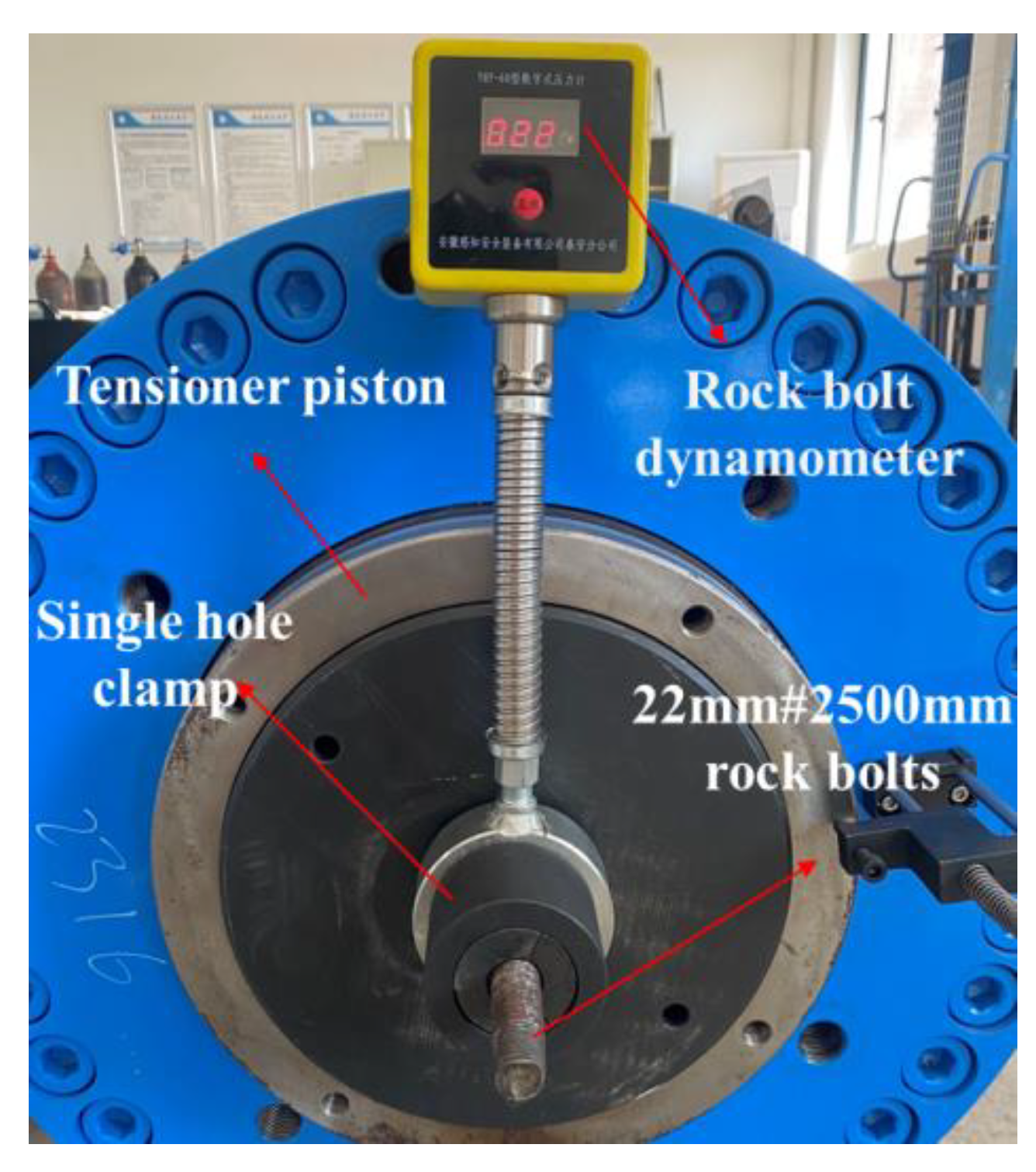

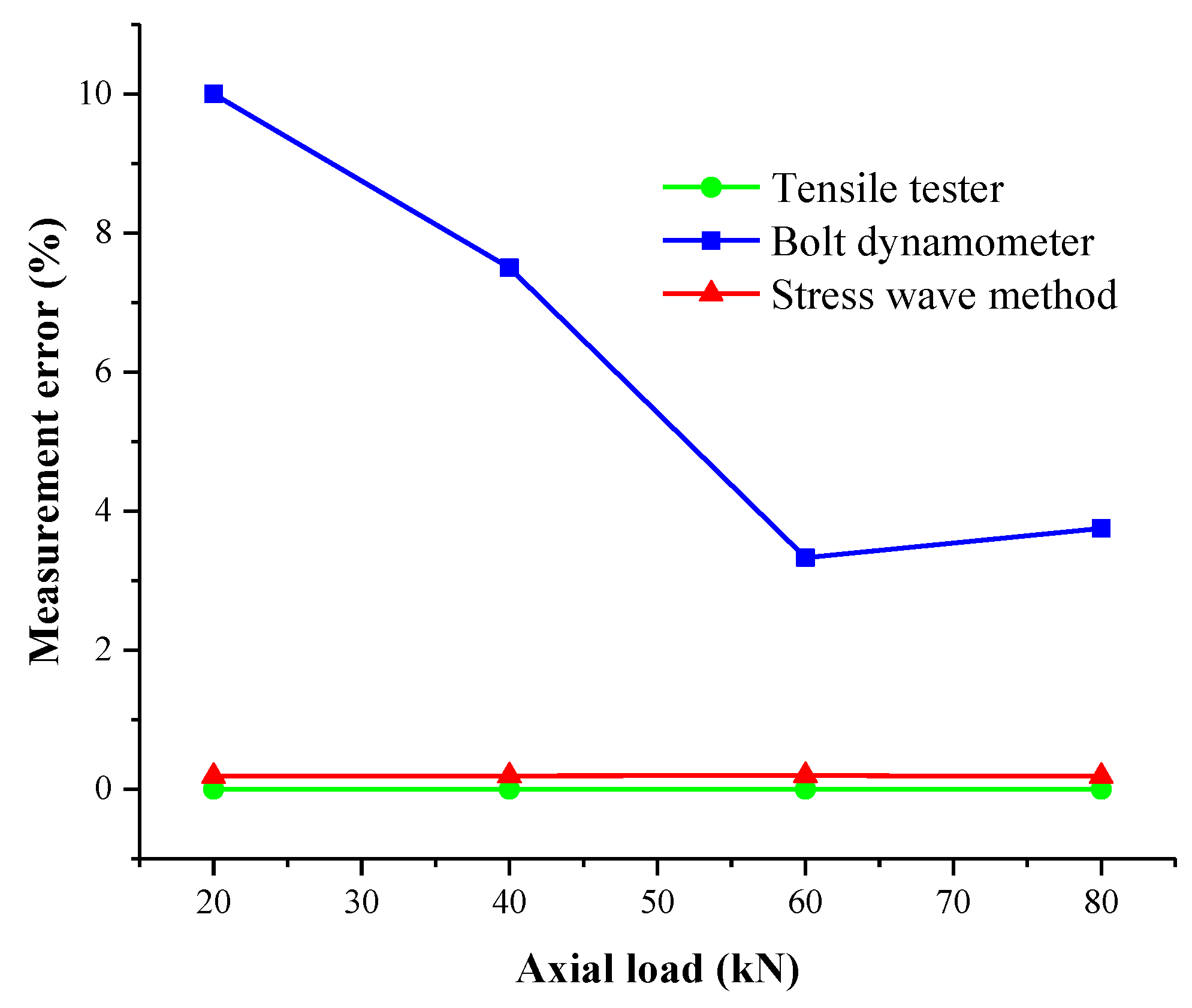
| Parameters | Values |
|---|---|
| Sampling rate fs/MHz | 1 |
| Sampling points N/K | 6 |
| Amplification gain L/dB | 62 |
| Emission energy E/J | 10 |
| Trigger threshold ϕ/(kV/m) | 800 |
| Axial Load (kN) | Root Mean Square | Variance |
|---|---|---|
| 0 | 21.6373 | 468.24695 |
| 5 | 17.1906 | 295.5644 |
| 10 | 17.308 | 299.61435 |
| 25 | 18.984 | 360.45103 |
| 45 | 20.881 | 436.08582 |
| 75 | 23.1176 | 534.50895 |
| 100 | 22.9296 | 525.85211 |
| Test Method | Measured Value (kN) | Measurement Error (Δ/20 kN) |
|---|---|---|
| Rock bolt pulling machine | 20 | 0% |
| Rock bolt dynamometer | 18 | 10% |
| Stress wave method | 19.917 | 0.185% |
| Test Method | Measured Value (kN) | Measurement Error (Δ/40 kN) |
|---|---|---|
| Rock bolt pulling machine | 40 | 0% |
| Rock bolt dynamometer | 37 | 7.5% |
| Stress wave method | 40.035 | 0.193% |
| Test Method | Measured Value (kN) | Measurement Error (Δ/60 kN) |
|---|---|---|
| Rock bolt pulling machine | 60 | 0% |
| Rock bolt dynamometer | 58 | 3.33% |
| Stress wave method | 60.056 | 0.197% |
| Test Method | Measured Value (kN) | Measurement Error (Δ/80 kN) |
|---|---|---|
| Rock bolt pulling machine | 80 | 0% |
| Rock bolt dynamometer | 77 | 3.75% |
| Stress wave method | 80.074 | 0.186% |
Publisher’s Note: MDPI stays neutral with regard to jurisdictional claims in published maps and institutional affiliations. |
© 2022 by the authors. Licensee MDPI, Basel, Switzerland. This article is an open access article distributed under the terms and conditions of the Creative Commons Attribution (CC BY) license (https://creativecommons.org/licenses/by/4.0/).
Share and Cite
Li, C.; Xia, X.; Feng, R.; Gao, X.; Chen, X.; Lei, G.; Bai, J.; Nie, B.; Zhang, Z.; Zhang, B. Experimental Study of the Effect of Axial Load on Stress Wave Characteristics of Rock Bolts Using a Non-Destructive Testing Method. Sustainability 2022, 14, 9773. https://doi.org/10.3390/su14159773
Li C, Xia X, Feng R, Gao X, Chen X, Lei G, Bai J, Nie B, Zhang Z, Zhang B. Experimental Study of the Effect of Axial Load on Stress Wave Characteristics of Rock Bolts Using a Non-Destructive Testing Method. Sustainability. 2022; 14(15):9773. https://doi.org/10.3390/su14159773
Chicago/Turabian StyleLi, Chuanming, Xin Xia, Ruimin Feng, Xiang Gao, Xiao Chen, Gang Lei, Jiankui Bai, Bochao Nie, Zhengrong Zhang, and Baoyou Zhang. 2022. "Experimental Study of the Effect of Axial Load on Stress Wave Characteristics of Rock Bolts Using a Non-Destructive Testing Method" Sustainability 14, no. 15: 9773. https://doi.org/10.3390/su14159773
APA StyleLi, C., Xia, X., Feng, R., Gao, X., Chen, X., Lei, G., Bai, J., Nie, B., Zhang, Z., & Zhang, B. (2022). Experimental Study of the Effect of Axial Load on Stress Wave Characteristics of Rock Bolts Using a Non-Destructive Testing Method. Sustainability, 14(15), 9773. https://doi.org/10.3390/su14159773






